About 40 million U.S. adults suffer from anxiety. According to Newsweek, “In the U.S., nearly 1 in 5, or roughly 43 million Americans, suffer from a mental illness, including conditions like depression, anxiety, or schizophrenia. These individuals often experience difficulty getting the health care that they need, and available medications don’t always provide satisfactory effects. For this and other reasons, many individuals coping with mental health issues seek alternative approaches to healing, including yoga.”
According to U.S.News, treating depression can be complicated, and may involve a whole lot of trial and error with different medications, types of therapy, and lifestyle changes. But one relatively straightforward and basically side-effect-free management option is regular yoga practice and yoga therapy, which recent research has shown can improve mood and anxiety measures in people with depression so significantly that they match those of non-depressed individuals. There’s nothing like the serenity, bliss, and relaxation that can come following a good yoga therapy session.
Research has revealed that yoga increases the levels of the neurotransmitter GABA. People who are struggling with anxiety and depression typically have low GABA levels. This makes yoga incredibly relevant to its use in the treatment of mental health conditions.
Yoga isn’t like other forms of exercise. In fact, it takes a unique, relaxed approach to fitness that comes as a refreshing contrast to many upbeat, intense, and modern workout classes. As such, yoga not only gets our blood pumping to elevate our mood; it also simultaneously soothes us into a state of relaxation through meditation and breathing techniques. This approach makes yoga an excellent option for those with anxiety and depression. In fact, many first-time yoga practitioners are surprised by how elevated their mood becomes after just one yoga class.
5 Easy yoga poses for anxiety and depression relief
Although there are hundreds of yoga poses, some are particularly good for dealing with anxiety and depression. Here, we will discuss 5 easy yoga poses and hand gestures (yoga mudras) that you can incorporate into your own practice to invite greater mental health into your life.
As you practice these, be sure to breathe evenly, steadily, and deeply, without straining your body. You can either breathe normally or use ujjayi breath throughout your practice. Doing this will help you remain calm in states of adversity, a skill that can help you stay grounded in many of life’s challenging moments!
1. Easy pose (Sukhasana)
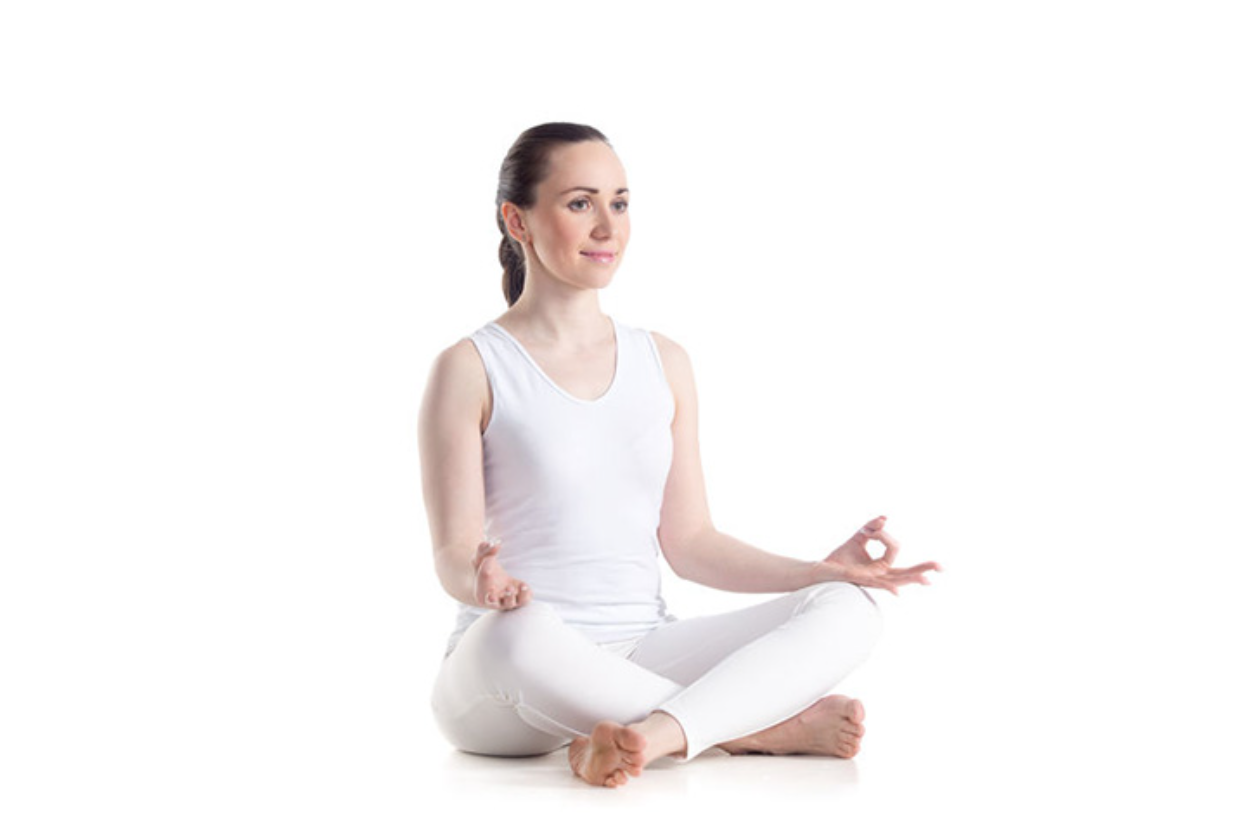
Easy pose is the classic position that you see people meditating in, sitting on the floor with crossed legs and a straight spine. In Easy Pose, the base of your spine connects to the earth, helping you feel deeply grounded. The symmetry of this posture also centers you. These two factors combined aid you in overcoming anxiety as you feel that nothing can uproot you or knock you off balance.
Furthermore, this pose helps to ward off depression as well. Sitting tall in perfect posture with easy, even, and smooth breathing, you can experience a sense of clarity, confidence, and strength.
Here’s how to do easy pose:
- Sit on the floor or a yoga mat with your legs crossed.
- Use a cushion or blanket to elevate your hips so that your knees are pointing downwards.
- Align your torso with your hips, keeping your spine straight and firm yet relaxed. If you like, you may also use some kind of back support like a wall or meditation chair.
- Lengthen your tailbone.
- Keep your shoulders and neck relaxed.
- Focus your attention on your heart. Keep your left palm on your heart and right palm on your navel. Close your eyes and take some deep, relaxed breaths. Feel the breath moving in your belly and chest area like a wave rising and falling.
- Remain here for as long as you’d like and you are comfortable.
As you sit in an easy pose, you can recite a mantra or watch your breath. Both of these are great methods for keeping your mind focused.
2. Child’s pose (Shishuasana or Balasana)
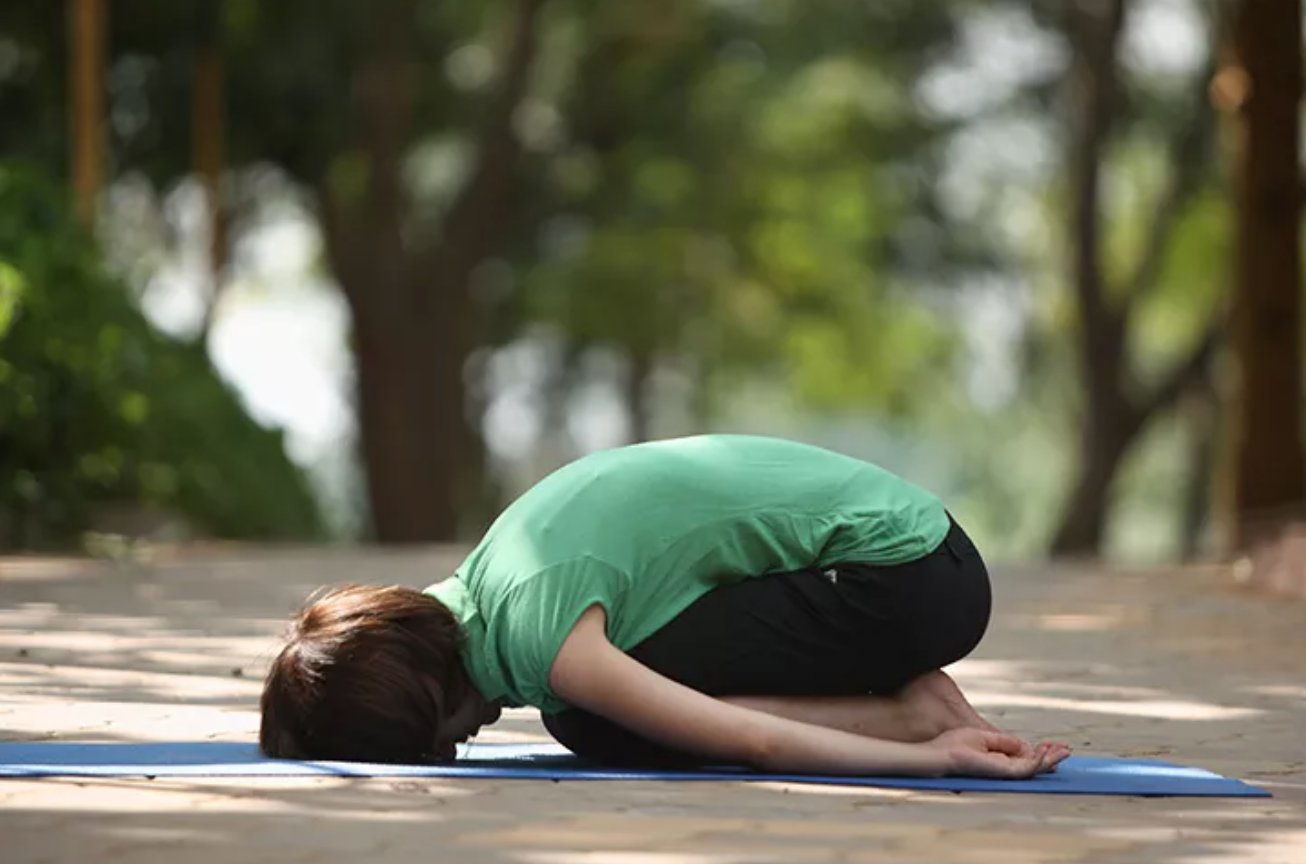
Child’s pose is among yoga’s most restorative and comforting postures. In Child’s Pose, you enjoy the immense comfort that comes with being totally grounded. The sense of being supported by the earth can provide great emotional comfort in times of anxiety and depression.
In addition to being comforting, child’s pose also works to release tension in the spine, thus calming your nerves.
To perform child’s pose, follow these steps:
- Kneel on your mat, and sit on your heels with your big toes touching and your knees slightly wider than your hips.
- Bend forward, stretching your arms and chest forward.
- Rest your head on your mat or a blanket with your arms stretched forward on either side of your head, palms resting on the mat.
- Breathe deeply and relax here for as long as you’d like before gently sitting back up.
3. Downward facing dog pose (Adho mukha svanasana)
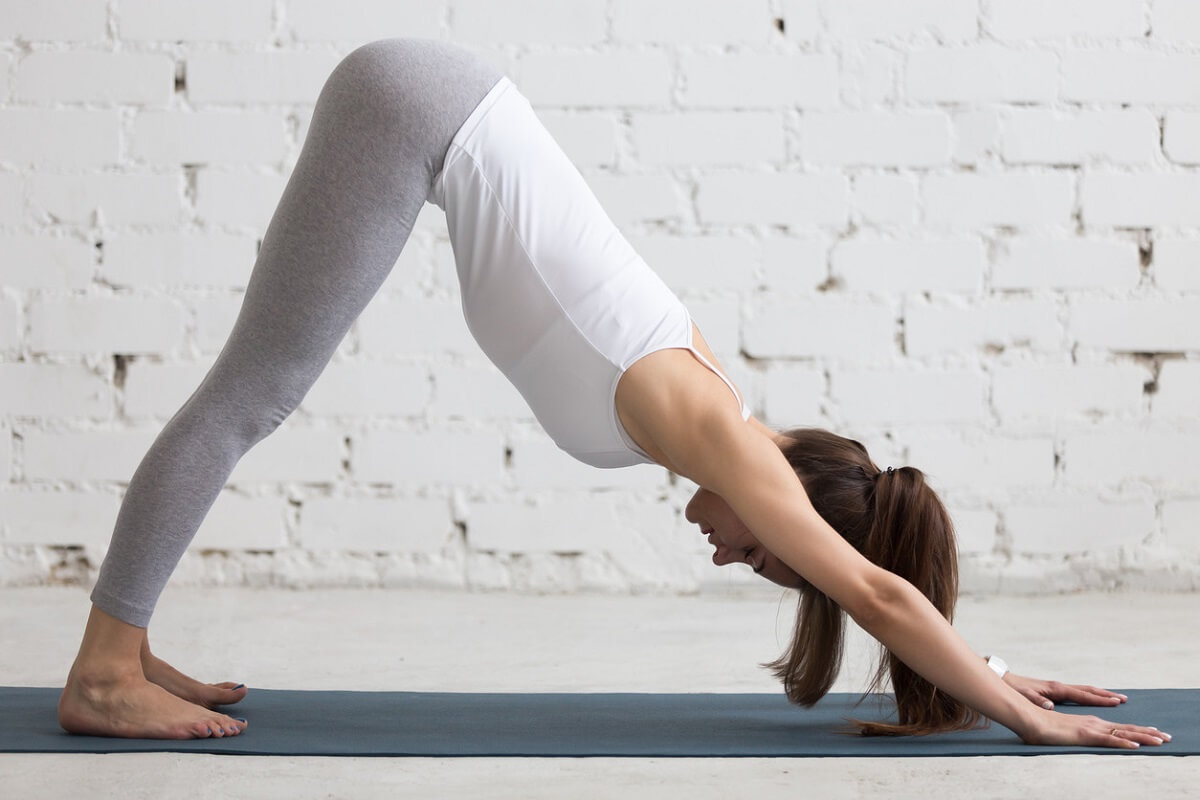
If you’ve explored yoga at all, you’re probably familiar with Downward-Facing Dog pose. There’s a good reason that this posture is quite popular in the yoga community: in addition to lengthening your spine and strengthening your arms, shoulders, and legs, it also increases blood flow to your brain. By amping up our circulation to this area, we can experience greater energy and mental clarity, helping us deal with issues that cause us stress or anxiety.
For Downward-Facing Dog pose, follow these steps:
- Come to all four on your hands and knees with a flat back.
- Lift your hips up by pushing against the ground with your toes.
- Straighten your legs and arms.
- Push against the ground with your hands to all your hips to rise up.
- Your body should come to an inverted v-shape.
- If you feel tightness in your legs, it’s OK to bend your knees.
- After taking a few breaths here, gently release the pose.
4. Upward-facing dog pose (Ūrdhva mukha svānāsana)
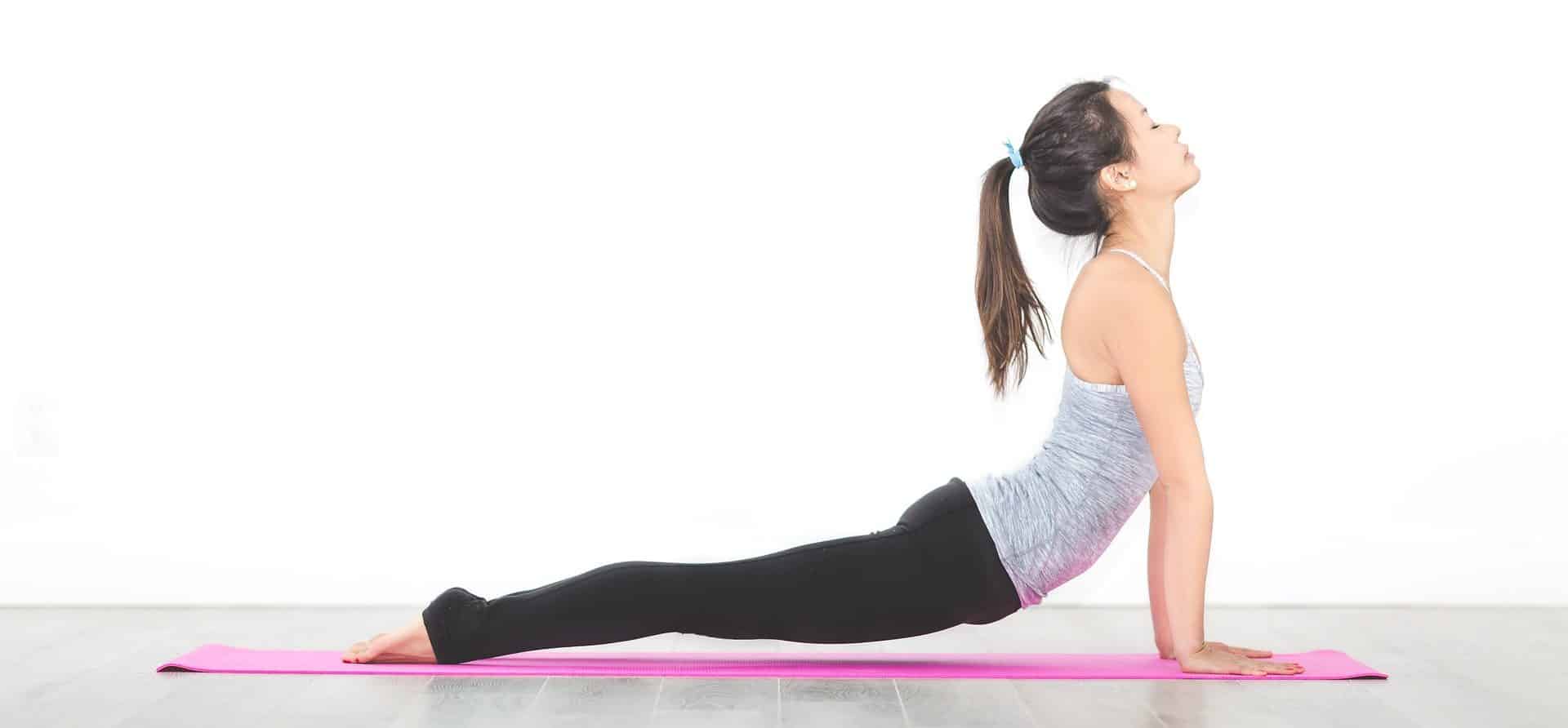
Another excellent pose for handling mild anxiety and depression is Upward-Facing Dog pose. This position opens your heart, helping you remove any pent-up emotions in your chest. It also works to regulate the respiratory system, bringing clarity to your heart and mind. It has an overall rejuvenating effect on your body, and all the stress trapped in your back will disappear.
For Upward Facing Dog pose, follow these steps:
- From Downward Facing Dog, push into your palms to elevate your upper body, smoothly curving the spine.
- Keep your knees off the mat and both legs fully stretched and straight.
- Lift your chest and head facing forward while keeping your shoulders broad.
- Lengthen your upper body in a nice curve and legs in a straight line.
- Take a few deep breaths here before gently releasing the posture.
5. Bridge pose (Setubandhasana)
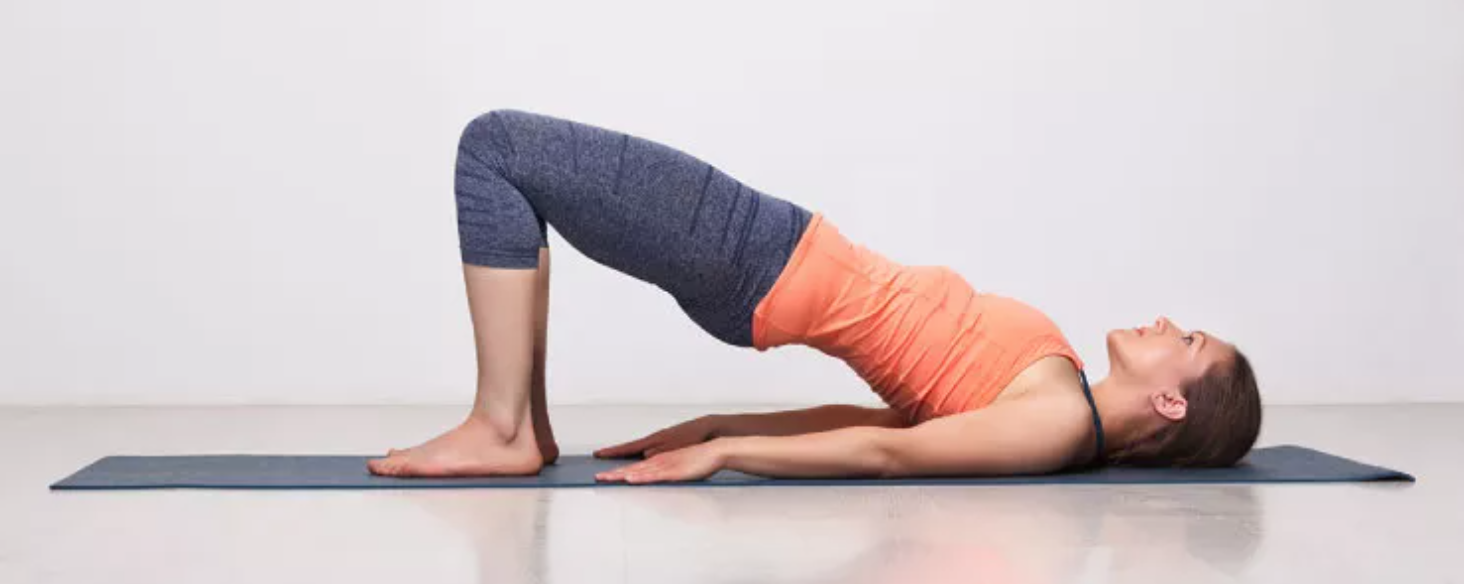
One of my favorite poses, Bridge Pose, calms the brain and helps alleviate stress and mild depression and reduces anxiety, fatigue, backache, headache, and insomnia as well.
Here’s how to do it:
- To begin, lie on your back.
- Bend your knees so that your feet are flat on the floor in a parallel position in line with your sitting bones, about a foot’s distance away from your hips.
- Place your arms by your sides with your palms facing down.
- As you inhale, begin to roll your spine upward as you lift your hips toward the sky. You will feel the lower, middle, and upper back sequentially peel off the mat. Support the weight of your body through your feet, ankles, and thighs rooting down into the ground.
- Squeeze your buttocks to keep a lift through your hips and keep your legs in a parallel position without collapsing or splaying outward.
- Maintain an easy breath as you strengthen your body in this pose.
- Hold the posture for 1-2 minutes and then release on an exhalation.
Try yoga mudras for anxiety relief
If you have been experiencing anxiety and stress, regular practice of these easy hand gestures can help you too.
Take a comfortable seat, and practice any of these mudras with slow and gentle breaths for 5-15 minutes. Find a rhythm with the breath. Try to make the inhale and exhale the same length–inhale for a count of 4, and exhale for a count of 4.
1. Gyan mudra
Touch the tips of the index finger and thumb and keep the other 3 fingers (index, ring, and pinky finger) stretched, relaxed and joined.
The Gyan mudra increases your mental alertness. It also prevents drowsiness. This mudra connects us to our higher Self, helps lift dull energy out of the body, creates a more receptive state, calms the mind, and brightens the overall mood. It is often used in meditation, pranayama, and asana.
2. Kalesvara mudra
Touch tips of middle fingers to each other. Touch the first two joints of the index fingers, and touch your thumbs. Bend the remaining fingers inward. Point your thumbs toward your chest and spread your elbows to the outside. Observe your breath and lengthen the pause after inhaling and after exhaling.
The Sanskrit word Kala means time, and Esvar means God or higher power. This mudra is dedicated to the God of time.
This mudra will bring down feelings of nervousness and calms down the agitated mind.
3. Uttarabodhi mudra
Hold the hands in front of the solar plexus. Interlock the fingers. Index fingers and thumbs of both hands should be joined together. While the index fingers point to the ceiling, point the thumbs to the floor.
Practicing Uttarabodhi mudra is a great way to calm an agitated mind or soothe the nerves before starting any seemingly overwhelming task.
Also known as the mudra for enlightenment, it is believed that Uttarabodhi mudra is great for improving self-confidence and realizing the inner Self. It removes fear and teaches one to not worry about anything and keep faith in a higher power.
Uttarabodhi mudra is also said to help problem-solving and decision-making, as well as improve focus and concentration.
4. Apan vayu mudra
The tip of the index finger should be pressed lightly against the root of the thumb and second and the third finger should touch the inner tip of the thumb.
Apan vayu mudra, also known as Mritsanjeevani mudra, is a very powerful mudra. In ancient India, it was believed to save lives in the case of heart attacks.
This mudra decreases the vata element within the body, so is very useful for people who have anxiety due to vata dosha imbalance. It reduces anxiety and regulates your hormones, so it is ideal for hyperactive and impulsive people.
5. Agni shakti mudra
Touch fingers of both hands to the palms, and join both tips of the thumbs together.
Next time you feel anxious and find yourself losing control, instead of biting your nails and panicking, try these simple hand gestures and find peace and serenity within yourself.
In addition to these yoga poses and mudras, meditation like SKY Breath Meditation and Sahaj Samadhi meditation are proven by various scientific studies to be of immense help in alleviating anxiety and depression.
If you struggle with mental health issues, talk to your healthcare provider and take advice about trying yoga. We recommend finding the yoga studio that is best for you and attending as often as possible. Not only will yoga make you feel great, but the sense of community that studios cultivate can give you the social support you need to feel better.
At the Art of Living Yoga Studio, we not only offer community classes but one-on-one private yoga therapy sessions too.
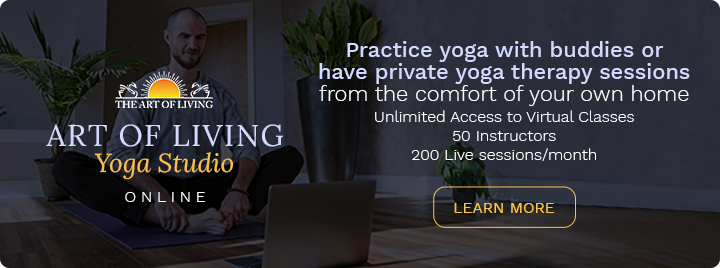
Yoga offers support, strength, and the ability to live in the moment. The unique mind-body approach of yoga is more and more becoming a popular choice for fighting depression. It’s holistic and long-lasting without any side effects. So, why not give it a try?

